Few things in life compare to the joy of playing bridge, but if I rack my brain I can think of one: watching other people playing bridge. Tuning in to BBO’s Vugraph is not just fun, but a great way of improving our own game. And it can be quite an ego-boost. It’s easy, looking at all four hands, to see how a contract should be played – how often have we all tut-tutted when someone goes wrong, convinced that we would have found the right line?
Kibitzing world-class players, however, the opposite is true – when they take a different line to the one we envisage, it shines a spotlight on our own limitations. The other day, while watching the Polish Premier League, 3NT was reached at both tables. Piotr Gawrys and Artur Malinowski were at the helm. It was obviously going to make, so I went to make a cuppa. On my return, I was amazed to see they had both gone down.
East led the ♥Q at both tables. Both Norths won with the ♥K. With the ♣Q coming down, all looks fine – right? No: they crossed to dummy’s ♠K and ran the ♣J! When it lost to East’s singleton ♣Q the contract was down. Any other way of playing clubs would have succeeded. Why was their line superior? East had opened 1♥, showing at least 5. So West was likely to have longer clubs, making it odds-on the ♣Q was with him. (Yes, East had opened, but there was room for West to have 5 points or so.) Why not cross to the ♣A to take a finesse? Because you need 4 or 5 club tricks, and you’d fail when West has Qxxx – more likely than East having the bare ♣Q. So there you have it – when two world-class declarers go down in a contract you or I would have made, it’s time to realise we just weren’t good enough to fail.






Comments